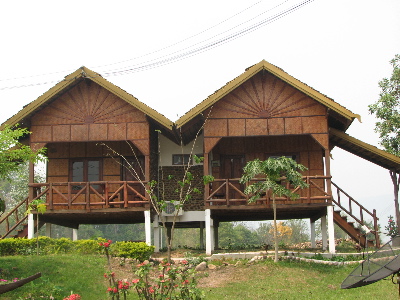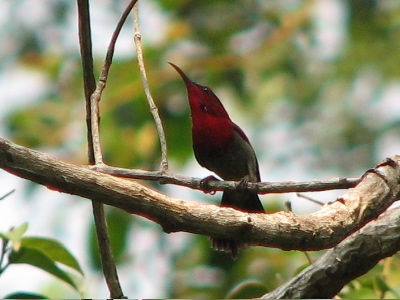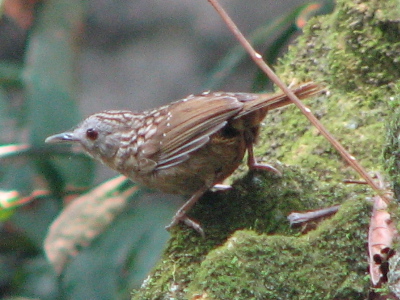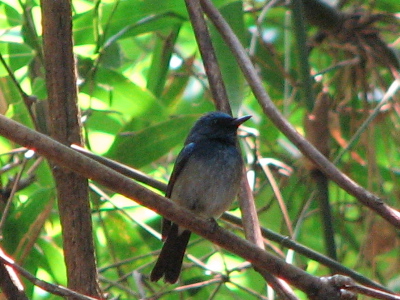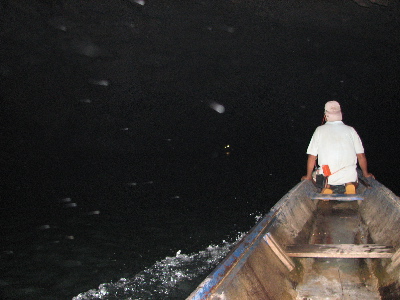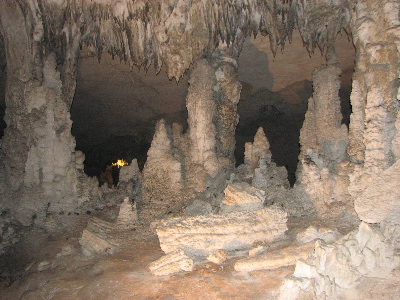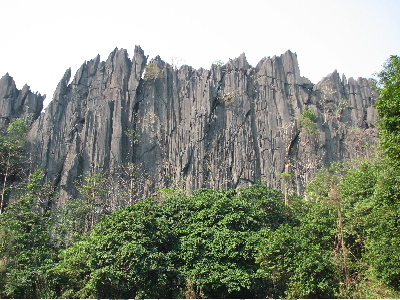
Trip report of birding Na Hin forest
Laos
3 to 8 March 2010
Trip overview
Trisha and I went to Laos in early March to check out the Na Hin area in preparation for a prospective Laos tour. Laos is largely an unexplored country, landlocked by Thailand, Vietnam, Myanmar, Cambodia and China. It has much of its forest intact. The key species sought were the recently discovered bare-faced bulbul and the near endemic, sooty babbler.
Other rarities recorded in the district in recent years are, among others, red-collared and pale-headed woodpeckers, blue-naped and eared pittas, red-vented barbet, spot-bellied eagle-owl and rufous-throated fulvetta.
Na Hin has a huge infrastructure project underway, namely an extension of the hydro-dam. The associated traffic makes birding difficult along Route 8 and trucks had rendered the trail at KM 44.3 useless when we were there. When the project winds down more peaceful birding will be had along Route 8 and its trails.
The southeast of Laos had had a poor wet season, which probably influenced our birding somewhat. However, we did get some great birds. Bare-faced bulbul and sooty babbler were found relatively easily and we also managed to see pale-headed woodpecker, white-tailed flycatcher, streaked wren-babbler and rufous-throated fulvetta, among others. We added to the current species list, rufous-winged buzzard and hill-blue flycatcher. http://www.birding2asia.com/W2W/Laos/NaHinList.html
We had unsatisfactory views of what were most likely golden-throated barbet and wreathed hornbill, again, new to the list if that is what they indeed were.
We hired a driver and 4WD from Europcar in Vientiane. Say (pronounced ‘sigh’) was great and spoke English well; our accommodation at Sainamhai Resort was good and the all-important food, excellent. We recommend Sainamhai Resort, which is away from the hectic Route 8. Importantly, staff were willing to cook breakfast at 5.30 am.
_________________________________________________
Day 1.
3 March 2010
We arrived in Vientiane from Bangkok on 3 March at noon and were met by Say, our driver, from Europcar. After going to the city office to do some paperwork, we headed off to Na Hin in eastern Laos not far from the Vietnam border on Route 8. We dodged rocks the size of basketballs on the road as we drove through the steep limestone hills en route to Na Hin village. The rocks are placed behind the wheels of the big buses coming from Vietnam to stop them rolling down the hill when passengers get out to lighten the load. It was not an uncommon sight to see people walking uphill behind a bus deficient in grunt.
It took us about five hours to reach Sainamhai Resort, which was to be our home for the next six days. We had a great meal and retired for the night after organising an early breakfast with the kitchen.
The cabins, designed by Mr Vongsamay, the owner, are made from rattan. They have air conditioning, which in March is essential by midday. Someone suggested that after sunset the area receives the cooling breezes from the Mekong River, which may be true as the night temperatures were pleasant.
Day 2
4 March 2010
Route 8 KM 34 to KM 36
We left Sainamhai Resort just after 6 am and had Say drop us off at KM 34 and we walked back down the hill (de-rocking the road as we went). We hadn’t birded in SE Asia for about ten months so we started slowly but confidence rose when we got some positive identifications under our belts: little spiderhunter, Arctic warbler, stripe-throated bulbul, crimson sunbird and thick-billed flowerpecker. A woodshrike gave us some trouble, we thought common but later realised it was large woodshrike. Other species along the Route included striped tit-babbler, black-crested and grey-eyed bulbuls, great iora, blue-winged leafbird, bar-winged flycatcher-shrike, white-bellied erpornis and grey-capped woodpecker.
The hydro project beyond Na Hin village was in full swing with convoys of trucks coming down the highway, including cement trucks from Thailand. This was tiresome and unconducive to birding. They also started early, so there was no escaping them.
We had a barbet with a large gold patch on its head perched (too) briefly in the scope, possibly a golden-throated barbet. A lovely male hill blue flycatcher was also seen along here. I thought Tickell’s initially as hill blue was not on the area’s species list but Uthai (our Thailand guide and an authority on birds of SE Asia) reviewed my photos and tape and said definitely hill blue. A shikra was seen, as were puff-throated bulbul, white-rumped shama, plain flowerpecker, green-billed malkoha, coppersmith barbet and streaked spiderhunter.
Say collected us at KM 36 and we returned to the resort for lunch. We met Iain Robertson from the Shetland Islands, a serious birder and former bird tour leader who had been to Deniliquin for plains-wanderer a couple of decades ago. Iain came out with us in the afternoon and we birded around KM 35 but we didn’t add much to the day’s list. Late in the afternoon, Troy Shortell, an American birder based in Singapore, pulled up with his driver. Troy, dressed in a suit and tie, had come straight from a conference in Vientiane. We all looked at him askance. The light fading we headed back to the resort.
Our first day had passed without the bare-faced bulbul or sooty babbler but we weren’t worried, we were just getting the lay of the land. (We had seen the silhouettes of two birds from the Lookout, way out on the limestone karsts, which were probably bare-faced bulbuls but too far away to care about).
crimson sunbird (male)
Day 3
KM 35 — 26
5 March 2010
Around 6 am we kicked off at KM 35 and slowly walked down towards Na Hin village. The party now comprised Iain, Troy, Trisha and me. Within 30 minutes or so we had located a group of bare-faced bulbul atop the limestone karsts. They were moving back and forward and appeared to be carrying food to young in a nest. While mostly quite high up, one came down lower but not low enough for photos. Perhaps not the handsomest of bulbuls but they did look rather dapper with the ruff across the throat.
Very shortly after we spotted a pair of sooty babblers. They were about a third of the way up the karst, which surprised me as I thought they would be feeding around the base. They were darker than what I expected and quite large — a lovely babbler belonging to one of my favourite bird families. These birds were busy feeding so were not calling, which is a shame as many of the babblers have interesting vocalisations. We watched them feeding among the bushes on the cliff face for about ten minutes before losing them.
Other species seen along here included white-browed piculet, yellow-browed warbler, black-throated sunbird and grey-headed canary flycatcher. We split up for a while with Iain and Troy going along the trail at KM 36 ahead of me. Down the trail a woodpecker was drumming but didn’t show itself. Lineated barbet, verditer flycatcher, black-winged cuckoo-shrike and Hainian blue flycatcher were added to the list. A vernal hanging-parrot flew over. When I caught up with Troy and Iain, they had seen three long-tailed broadbill.
Trisha and Iain returned to the resort with Say and Troy and I continued birding. We lured a streaked wren-babbler down from the karst at the end of the trail. Troy had been up on top of the karst earlier (no mean feat) and had some sort of laughing-thrush up there. That bird remains a mystery. Bronzed drongo was seen before we headed back to the resort for lunch.
streaked wren-babbler
After lunch and a rest, Iain and I and later Troy met at KM 48 trail, which leads up to primary forest. It was a relief to get away from the highway with its incessant traffic and actually hear birds calling. Along this trail we had scarlet minivet, bar-wing flycatcher-shrike, grey-eyed and black-crested bulbuls, many orange-bellied leafbirds, striped tit-babbler and Japanese white-eye. We only got as far as the track that goes off into the primary forest before the light failed and dinner beckoned back at the resort.
Laos people know how to party and the village reverberated with the banging of drums well in to the wee hours of the morning. The village was celebrating an important festival — a festival to bring good luck to the village (and as Trisha said, bad luck to people who wanted to sleep). We wondered at dinner where Troy could be.
Day 4
6 March 2010
KM 48 trail
“The natives were restless last night”, I said to a bright-eyed Troy at breakfast. “I was with them, we sacrificed a couple of goats!” he says. “Better goats, than virgins”, retorts Trisha, who had read some gruesome Laos mythology about sacrificial virgins in Natacha du Pont de Bie’s book, Ant Egg Soup — The Adventures of a Food Tourist in Laos. Laos whisky, brewed from bark (and said to have virility properties) and cheaper than the ridiculously cheap Beer Laos, was the tipple of choice (we believe).
Iain, Troy and I were back at the KM 48 trail after breakfast. Iain and Troy went ahead and I slowly birded the trail through the regrowth forest with just a few scattered big trees. I added a pair of Hainan blue flycatchers, green-eared, blue-eared and moustached barbets, ashy drongo and a gorgeous pair of velvet-fronted nuthatches that came up close. Troy’s time in Laos was up so we said our goodbyes to him.
Hainan flycatcher
In the primary forest I had what I initially thought was white-tailed robin but on Uthai’s examination of my photos and tape, I now know it to be white-tailed flycatcher; a superb male and in full song. It didn’t show as much white on the belly as the field guide indicates. Other species in the primary forest were buff-breasted babbler, red-headed trogon, Asian paradise flycatcher, white-bellied erpornis, hair-crested drongo, greater flameback, purple-naped sunbird and blue-winged leafbird. White-crested laughing thrush was heard but not seen. A group of black bulbuls with quite variable amounts of white on their heads and breast was seen.
Iain and I returned in the late afternoon to bird til dark and try for some owls. Two of the many mountain scops owl that were calling came in close but still we could not see them. Not much else about other than a pretty native rat that was chestnut brown above with lovely white contrasting underparts — possibly Indo-Malayan niviventer.
In the morning Trisha and Say had headed off to the Kong Lor limestone cave, about 40 kilometres away, for a boat trip on Nam Hinboun. On arrival they were aghast to find about a dozen tourist buses and hundreds of people. Say quietly said, “big goof!, meaning he had stuffed up by forgetting it was a public holiday. ‘The expression ‘big goof’ has entered Trisha’s vernacular.
Day 5
7 March 2010
KM 48 trail
This was our last full day in Laos so I made the most of it. Say dropped me off at the KM 48 trail at 6.30 am and collected me at 5.00 pm. I worked hard for not a lot of birds but there were some bright spots. Asian fairy bluebird, black-naped monarch, green-bill malkoha and grey-throated babbler were added in the morning. Near the start of the primary forest a beautiful call was heard in the thick undergrowth. A rufous –throated fulvetta finally showed itself. A large hornbill with noisy wing beats and no white on the wings flew over while I was down at the base of the steep hill in the tall forest. It was probably a wreathed but I did not get enough on it to be sure. A woodpecker called in the primary forest towards the end of the trail; much effort went into seeing what turned out to be pale-headed woodpecker. I have only seen this species once before and that was in Vietnam. Radde’s warbler was seen in the secondary forest on the way out. Quite a few striped squirrels (uncertain as to the species) and one Pallas’s squirrel were seen during the day.Exhausted, I returned to the resort. Iain had also birded the KM 48 trail but had come back earlier. He had seen some of the same species I had but had also added maroon oriole.
Trisha and Say had returned to the Kong Lor cave for the 7.5 km boat trip, without the weekend’s throng. The adventure had everything Trisha loves — a boat, a river, a cave … but the thing she remembers most about it was the number of times she had to get out of the boat – hundreds, but that could be an exaggeration. Still it is not every day that you go down an underground river and see amazing stalactites and other limestone formations and she would do it again in an instant — preferably in the wet season when there is a huge volume of water rushing through.
Day 6
Sala Viewpoint; KM 44.3 road; trail to Namsanam Waterfall
Our first stop this morning was the Viewpoint at KM 34 to look for the endemic Laos langur. These monkeys like to sit up on the limestone karsts and catch the rays of the early morning sun. They were distant but not bad in the scope — they looked like they were wearing party hats.
We headed to the KM 44.3 road, which leads to one of the hydro projects. Iain and I walked it but it was useless — endless traffic and dust. We then birded the waterfall trail behind the temple in the village. It was hot by this time so not a lot about but we added yellow-vented flowerpecker and a group of minivet, which were probably ashy. A probable brown hawk-owl was seen fleetingly. Laos village men are natural born hunters and being so close to the village this area must cop a hammering. We came across a mist net spanning a dry creek bed; I suspect not a banding project! Still, who can judge people who live a hand-to-mouth existence and are doing what their forefathers have done since time immemorial. (But perhaps not with mist nets). As we know in Australia, there is a downside to native people losing parts of their cultural identity. Hopefully with Laos becoming a birding destination, young Laos men will be able to channel their innate bush skills to professional guiding.
On the way back to the resort a pair of shikra attended an active nest on the far side of the water impoundment and a rufous-winged buzzard flew across.
A final lunch at Sainamhai Resort and a sad farewell to Mr Vongsamay and his family who had looked after us so well. Trisha still hankers after the tempura style yam-fried morning glory and yam vegetables we ate every night we were there (among a lot of other offerings). The nin (nine) fish was very good and the green papaya salad unashamedly spicy. A cold Beer Laos was popular but for our money Sainamhai’s icy mango milkshakes hit the spot after a long, hot, morning’s birding.
Iain headed off the next day into the Annamite mountains up near the Vietnam border where few birders have ever gone.We count the days before we return to Laos.
____________________________________________________
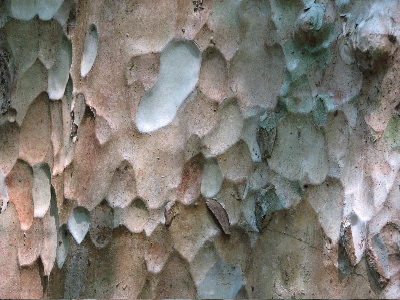
interesting bark
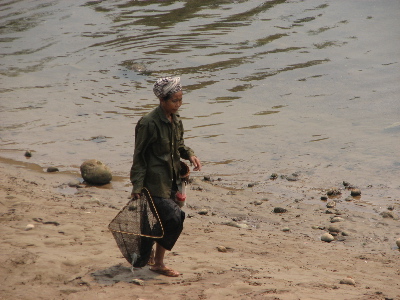
Laos woman along the river in front of Sainamhai Resort
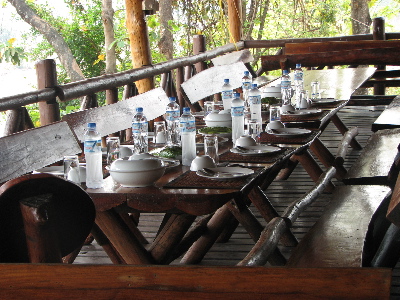
dining table at Sainamhai Resort
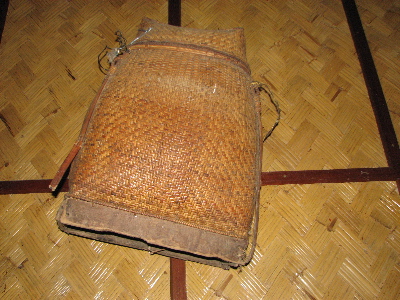
traditional woven basket, Sainamhai Resort
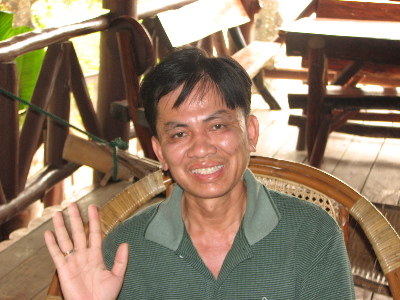
Mr Vongsamay, Sainamhai Resort
